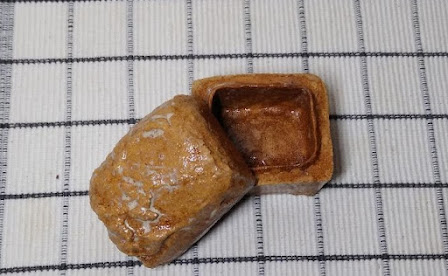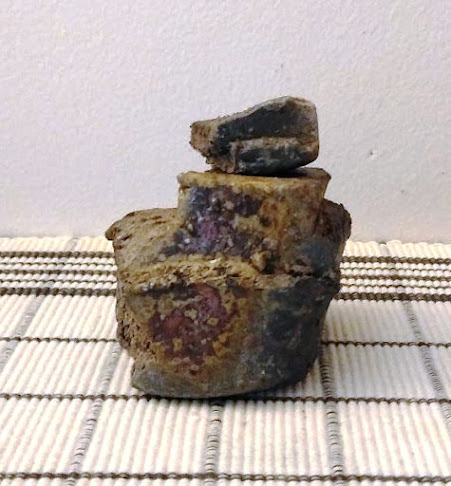148. Anonymous, splashed glazed vase
Red clay, a blue underglaze, a khaki green overglaze, and
splashed darker green glaze; base left unglazed. Weight: 1774 g (4 lb). Rim
diameter: 12.7 cm (5 in), maximum diameter: 14.7 cm (5-3/4 in); foot ring diameter: 8.7 cm (3-3/8 in). Height: 22.7 cm (9 in).
This sits on the base of the foot ring, which is a scant
1/16 inch high on the exterior; the interior of the base was hollowed out to a
similar depth. Above the foot ring, the walls have been carved out in a concave
shape to a height of about 0.6 cm (1/4 in). There is a slight groove at the
edge of this. Above this, the walls rise in a shallow convex arc to the
shoulders, which are about 14.7 cm (5-3/4 in) above the base. From there the
walls turn inward in more or less a straight line to the base of the neck,
which is 17.8 cm (7 in) above the vase. At this point the diameter is 9 cm
(3-1/2 in). The walls then curve outward in a deep concave arc to the rim. The
rim is slightly rolled. The shape is symmetrical, and the texture is smooth
over the glazed portions. Just above the unglazed base at the bottom of the
glazed area, a potter’s mark was impressed into the wall of the vase. It is
circular, with a design of petals inside, 1.2 cm (1/2 in) in diameter.
Except for foot ring and the area immediately above it,
the pot is glazed. The blue underglaze is visible on the interior of the vase,
along a narrow band at the bottom of the glazed area on the exterior, and
peeking through at random places on the exterior. The khaki green color
dominates the exterior. The darker green glaze was splashed over the neck and
shoulders of the vase, running down into the main body, in two arcs on opposite
sides of the piece.
According to the seller, the “clay body is similar to
that used at the Pacific Stoneware Pottery of Bennett Welsh” in Oregon. Pacific
Stoneware Pottery was a large operation that produced both hand-thrown one-of-a
kind pots and mechanized, mass-produced pottery. The seller dates the pot to
the mid-1960s.
The shape used to be more common than it is nowadays. The
design is typical of the classical shape and restrained decoration of the
period.
Purchased from Charlie B. Gallery in Carson City, Nevada,
September 2021.


































